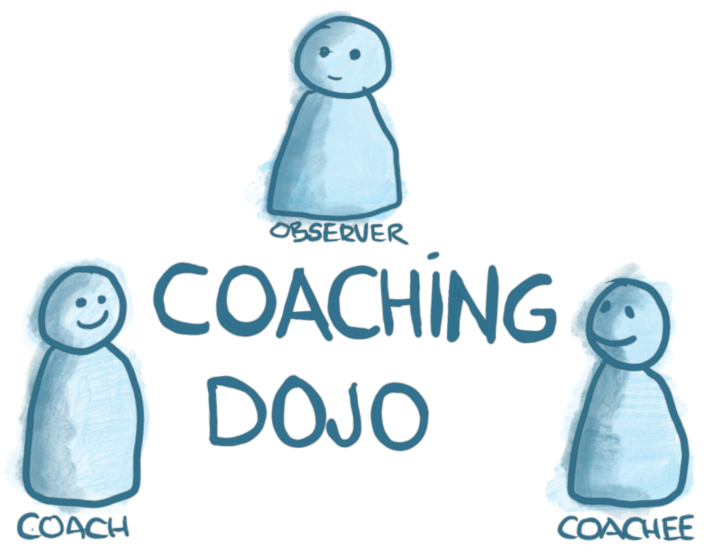Coaching dojo
6 min read
In the world of agile methods, the term coach has been used since the beginning as the person supporting the development team to achieve their objectives. Kent Beck discussed how to choose a coach in his Extreme Programming Explained [1, p. 143]. Other authors went deep to discuss the roles of the coach, influenced by their training as personal coaches [2].
My initial exposure to the term coach was through the agile community and I understood that it was about asking the right questions and helping people get to solutions using their own resources. In one meetup I had the chance to practice that coaching thing in a coaching dojo.
What is a coaching dojo?
Dojo is a Japanese word that means “the place where you practice”. Some people started to talk about coding dojos [3] to describe a way to improve coding skills by practising exercises named code kata [4]. I don’t know how, but somebody thought that the idea of learning by repetition and deliberate practice could also be used for coaching.
The facilitators in my first coaching dojo told us to split in groups of three. In each group we had to distribute three roles. We would do three rounds, so that each one in the group could experience each role. Each round would be 6 minutes plus 3 minutes for feedback. The roles were:
- Coach, who is going to practice coaching skills.
- Seeker or coachee, who comes with a (real) problem to solve.
- Observer, who is going to observe the interaction and provides feedback to the coach at the end of the round.

It was a great experience that I repeated in many other meetups and conferences, also in different formats.
The positives
The first time I participated in a coaching dojo I observed how other participants asked good questions, how difficult it was for me to find good ones and how important the feedback was to improve. I’ve been able to practice coaching dojos several times and even included the exercise in some of our courses. It is about coaching, not agile coaching.
People from different backgrounds, with no knowledge of agile, usually have a sensation of awe during the exercise. As facilitators, we talk about a “safe environment” and a good level of “trust”. We ask coaches to “stay curious as much as possible” and to “ask open-ended questions”. We ask seekers to find a real topic that worries them but could not take time to think about it. As coaches they realise how difficult it is to avoid offering a solution and staying in the problem as much as possible. As observers they see how important it is to pay attention to the questions, not to the answers. As a group, that bubble of trust is sometimes very powerful. Staying humble and silent when receiving the feedback is sometimes hard. And not commenting on the topic during the feedback time but how the interaction was, is the most difficult part.
One small concern
After doing my learning on coaching I realised that when participating in coaching dojos, often we were practising before learning, without expert observers. We were putting in practice something that we had an intuition about, but we didn’t know.
An image came to my head. I imagined myself interested in Kung fu but with the knowledge of someone who has viewed a couple of movies. I could try to copy the actors’ movements, and I could go to the park to practice with my friends, with the same knowledge on the subject as me. A kick here. A punch there. Now a pose. Then being corrected by someone who does not know.
“coaching dojo was like practising Kung fu in the park with my friends.”
It can be fun, it is exercise and it can be beneficial, but it is not learning Kung fu. You cannot practise what you don’t know. You cannot learn by only practising (even though Plato, in the theory of recollection described in Phaedo, says that to learn is to recollect).
Learn and improve
I realised that an important component of the coaching dojo, or any other practical exercise, is to explain the basic techniques so that participants can practise something they have learned. Or that the facilitator ensures that only the seekers don’t know about coaching in the first iteration and the feedback time is used to do some teaching.
Participants must understand what is good listening. To distinguish leading questions from open-ended questions. To stay curious. To listen to what is not said. To read the whole body. Coaching is more than asking questions.
A short round of a coaching dojo cannot be like a course but can hep you learn how to ask coaching questions.
Go and practice. Keep your love for learning. And be cautious when you realise you are practising Kung fu in the park with your friends.
Toni Tassani — 4 April 2022
This article was originally published on 22 February 2021 on the company intranet.